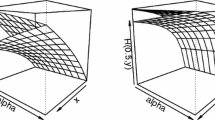Abstract
In a previous paper the fuzzy characterizing function of a random fuzzy number was introduced as an extension of the moment generating function of a real-valued random variable. Properties of the fuzzy characterizing function have been examined, among them, the crucial one proving that it unequivocally determines the distribution of a random fuzzy number in a neighborhood of 0. This property suggests to consider the empirical fuzzy characterizing function as a tool to measure the dissimilarity between the distributions of two random fuzzy numbers, and its expected descriptive potentiality is illustrated by means of a real-life example.
Access this chapter
Tax calculation will be finalised at checkout
Purchases are for personal use only
Similar content being viewed by others
References
Couso I, Dubois D (2014) Statistical reasoning with set-valued information: Ontic vs. epistemic views. Int J Appr Reas 55(7):1502–1518
Diamond P, Kloeden P (1999) Metric spaces of fuzzy sets. Fuzzy Sets Syst 100:63–71
Lubiano MA, De la Rosa de Sáa S, Montenegro M, Sinova B, Gil, MA (2016) Descriptive analysis of responses to items in questionnaires. Why not using a fuzzy rating scale? Inform Sci 360:131–148
Lubiano MA, Montenegro M, Sinova B, De la Rosa de Sáa S, Gil MA (2016) Hypothesis testing for means in connection with fuzzy rating scale-based data: algorithms and applications. Eur J Oper Res 251:918–929
Meintanis SG (2007) A KolmogorovSmirnov type test for skew normal distributions based on the empirical moment generating function. J Stat Plan Infer 137:2681–2688
Mora J, Mora-López L (2010) Comparing distributions with bootstrap techniques: an application to global solar radiation. Math Comp Simul 81:811–819
Nguyen HT (1978) A note on the extension principle for fuzzy sets. J Math Anal Appl 64:369–380
Puri ML, Ralescu DA (1986) Fuzzy random variables. J Math Anal Appl 114:409–422
Sinova B, Casals MR, Gil MA, Lubiano MA (2015) The fuzzy characterizing function of the distribution of a random fuzzy number. Appl Math Model 39(14):4044–4056
Zadeh LA (1975) The concept of a linguistic variable and its application to approximate reasoning, Part 1. Inform Sci 8:199–249; Part 2. Inform Sci 8:301–353; Part 3. Inform Sci 8:43–80
Acknowledgments
Authors are grateful to Colegio San Ignacio in Oviedo-Asturias (Spain) for allowing us to collect the data in the real-life example. The research in this paper has been partially supported by/benefited from Principality of Asturias Grant GRUPIN14-101, and the Spanish Ministry of Economy and Competitiveness Grants MTM2015-63971-P and MTM2013-44212-P. Their financial support is gratefully acknowledged.
Author information
Authors and Affiliations
Corresponding author
Editor information
Editors and Affiliations
Rights and permissions
Copyright information
© 2017 Springer International Publishing Switzerland
About this paper
Cite this paper
Lubiano, M.A., Gil, M.Á., Sinova, B., Casals, M.R., López, M.T. (2017). Measuring the Dissimilarity Between the Distributions of Two Random Fuzzy Numbers. In: Ferraro, M., et al. Soft Methods for Data Science. SMPS 2016. Advances in Intelligent Systems and Computing, vol 456. Springer, Cham. https://doi.org/10.1007/978-3-319-42972-4_40
Download citation
DOI: https://doi.org/10.1007/978-3-319-42972-4_40
Published:
Publisher Name: Springer, Cham
Print ISBN: 978-3-319-42971-7
Online ISBN: 978-3-319-42972-4
eBook Packages: EngineeringEngineering (R0)




